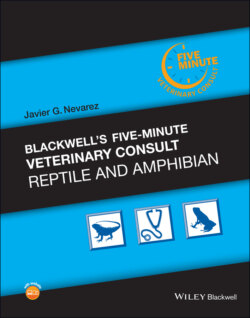Читать книгу Blackwell's Five-Minute Veterinary Consult: Reptile and Amphibian - Javier G. Nevarez - Страница 89
APPROPRIATE HEALTH CARE
ОглавлениеTreatment often requires a combination of medical and surgical therapy for best results.
Any suspected or confirmed bacteria should be treated with appropriate systemic antibiotics until results of sensitivity panel confirm its effectiveness.
For suspected fungal infections, systemic therapy may not be necessary, as long as the infection is restricted to the abscess.
In conjunction with medical therapy, surgery to either remove or debride the abscess must be performed.
Complete removal of the whole abscess and capsule is preferred but often not possible due to size limitations for skin closure or involvement of underlying tissues. A debridement is more commonly performed.
The abscess should be opened to extract the purulent material and as much of the capsule as possible. It can then be irrigated with a disinfectant solution (iodine, clorhexidine, etc.) and left open to heal by secondary intention.
Daily flushing and cleaning should be performed until no more purulent material is observed.
Topical antibiotic ointments can also be applied within the abscess cavity. An additional treatment is the placement of antibiotic (amikacin, cephalosporins) impregnated beads, or dental antibiotic gels, such as doxycycline hyclate (DOXIROBE® gel, Zpetis, USA), or clindamycin hydrochloride 1% (ClinzGard®, VEDCO Inc, USA) especially in non‐responsive cases, fractious animals, or those that cannot be easily treated on a daily basis
Most abscesses will take between 2 weeks and 1 month to heal. In some cases, once the caseous material has been completely removed and there is certainty that only healthy tissue remains, then the wound can be sutured.
